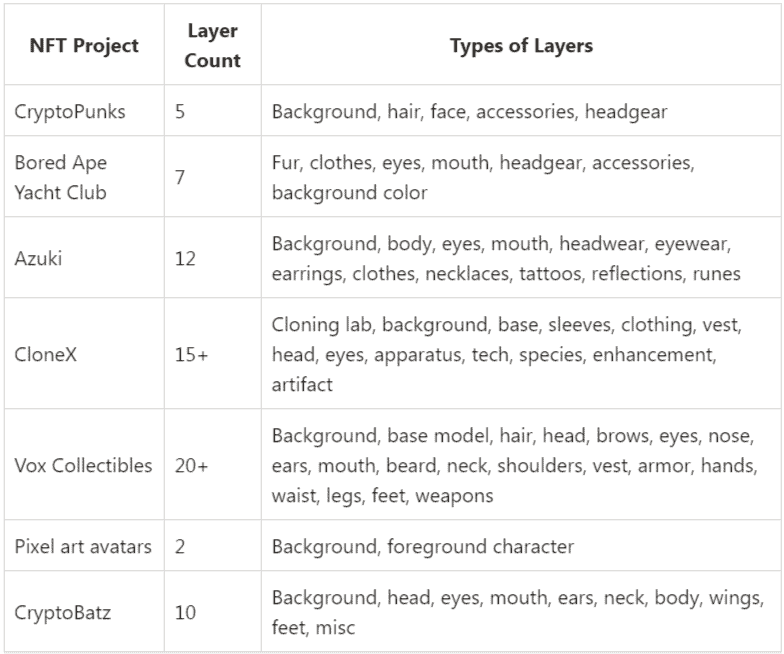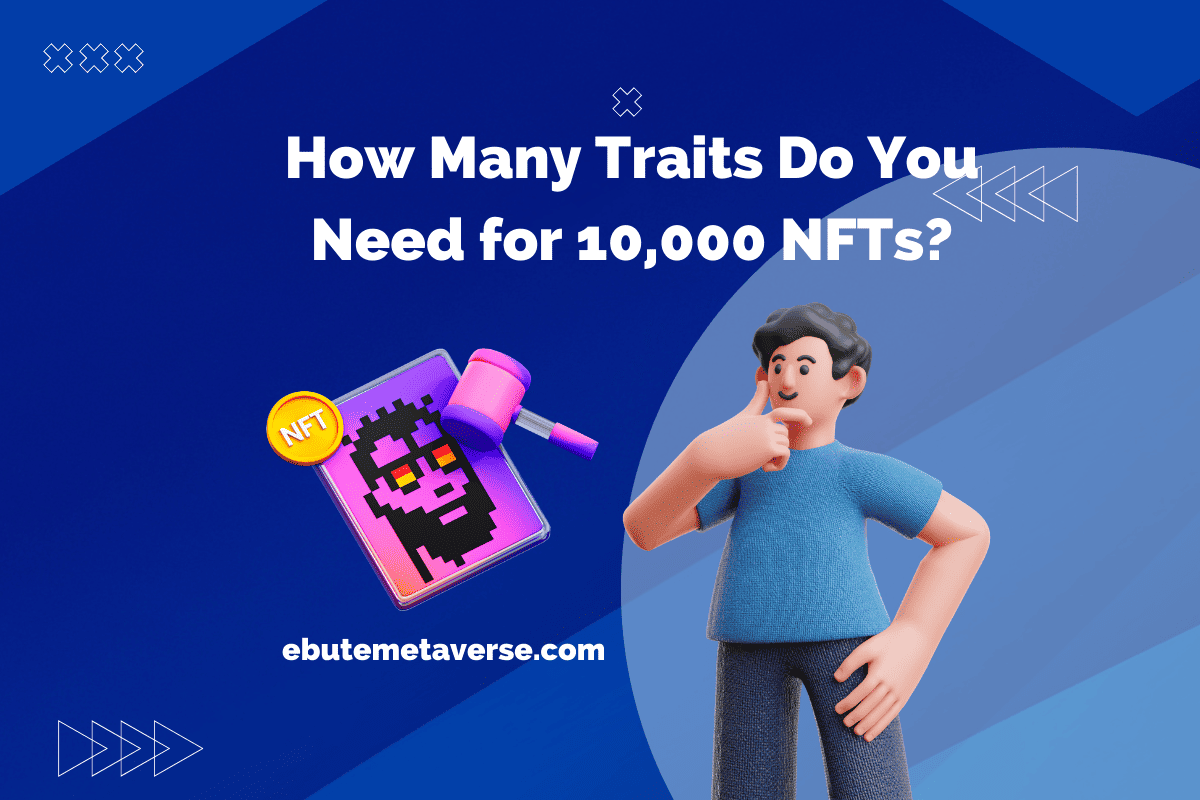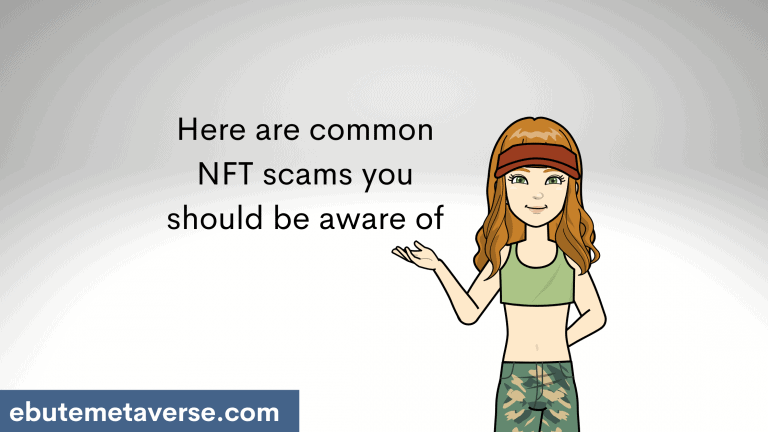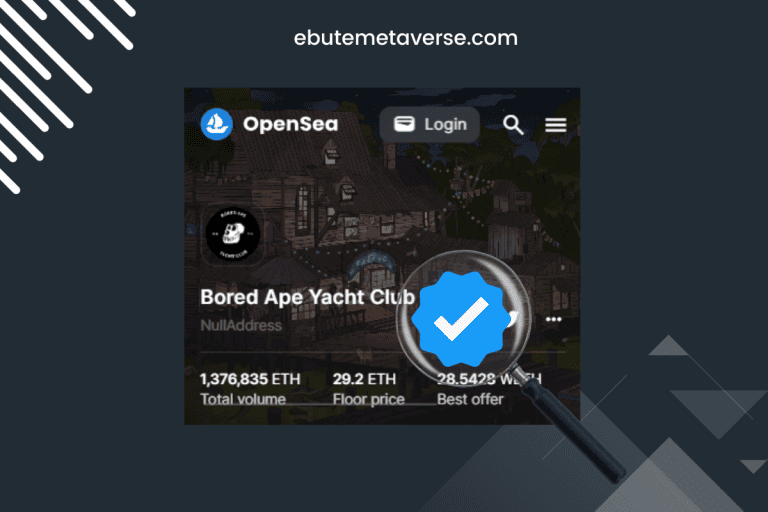How Many Traits Do You Need for 10,000 NFTs?
Once you figure out the number of layers you want (background, head, eyes, hair, body, clothing, etc.), you can get a specific number of traits your 10,000 NFT collection has.
For example, you need four layers with 10 traits each to create 10,000 NFTs. This is because the number of NFTs you can make equals the number of traits to the power of your layers’ number. For example, 10 ^ 4 = 10,000.
But this doesn’t account for unique traits or other rarities.
So, how do you figure out how many traits you need for your 10K NFT collection?
How Many Traits Do You Need for 10,000 NFTs?
You can approach this question in three ways:
- the same number of layers and traits
- different traits per layer
- estimate using our NFT traits calculator.
But first, what is a trait and what is a layer?
Layers:
Layers form the different components that make up each NFT’s artwork. For example, the background art, the base character, accessories, and props. Layers stack on top of each other to form the final composite image.
For example, some layers for an anime character NFT collection could be:
- Background
- Body
- Eyes
- Clothing
- Hair
Traits:
Traits refer to the attributes or characteristics that make each NFT unique within a collection. For example, eye color, clothing type, facial expression etc. Each trait type can have multiple variations (e.g. blue eyes, green eyes).
For the same anime collection example, some corresponding traits across those layers will include:
- Background color (desert, city, space)
- Body tattoo (dragon, skeleton)
- Eye expression (happy, angry)
- Clothing type (casual, formal)
- Hair length (short, long)
Now, let’s break down the two ways to know how many traits you need for 10,000 NFTs.
The Same Number of Layers and Traits
This method is simple to calculate since you’re using the same number of traits for every layer.
Your formula would be like this:
Number of traits per layer = (Desired total number of NFTs)^(1/Number of layers)
To explain further:
- Desired total number of NFTs = The total variety of NFTs you want to generate (e.g. 10,000)
- Number of layers = How many layers your NFTs have (e.g., 4)
^ = Raised to the power of
So to get 10K NFTs:
- Number of traits per layer = (10,000)^(1/4) = 10
This tells us we need 10 trait options in each of the 4 layers to be able to generate 10,000 total NFT combinations.
Different Traits Per Layer
Having varying traits per layer creates more unique NFTs. But the math gets harder.
The formula is now:
Total NFTs = Number of traits in Layer 1 x Number of traits in Layer 2 x Number of traits in Layer 3 x …and so on
For example:
- Layer 1 has: 7 traits
- Layer 2 has: 8 traits
- Layer 3 has: 12 traits
- Layer 4 has: 15 traits
To get the total number of possible NFTs:
7 x 8 x 12 x 15 = 10,080 total NFT combinations
The simplest way to understand this is:
- Count how many trait options each layer has
- Multiply those trait numbers together
- The result is how many different NFTs you can make
It’s more complex than raising to a power but gives more control over the rarity between layers.
NFT Layer and Traits Calculator
|
Total Combinations: 0 |
||
Here’s how to use the NFT layer and trait calculator:
- Set Layers: Enter the number of layers for your NFTs in the “Number of Layers” box and click “Set Layers.” This creates input fields for each layer.
- Enter Traits: In the new fields, input the number of different traits for each layer.
- Calculate: Click “Calculate” to see the total number of unique NFT combinations possible, displayed under “Total Combinations.”
How Many Layers Do You Need for an NFT?
The average number of layers for an NFT is 5. However, there is no set number of layers required for an NFT. It all depends on the size of the collection and how many traits you want it to have.
For instance, Cryptopunks has five layers, and Bored Ape Yacht Club has 7 layers. Azuki has 12 and CloneX has over 15 layers.

Here are some general guidelines around layers for NFT art:
- At minimum, an NFT would need a base layer, which is the underlying image or artwork. This forms the foundation.
- Most NFT artworks have between 2–10 layers stacked on top of each other. This allows for more visual complexity and more potential unique combinations.
- Typical layers can include backgrounds, characters, accessories, props, color adjustments, etc. Each layer adds more customizable elements.
- More layers means more potential unique permutations of the NFT art. This scarcity can increase the perceived value.
- However, too many layers can make the NFT metadata excessively large. Most NFTs aim to keep the total metadata size under 1-2 MB.
- So the ideal number of layers balances visual uniqueness with manageable file sizes. Five layers is common, but complex NFT projects may have 20+ layers in some cases.
Steps for Creating a 10,000 NFT Collection
So, now that you’ve wrapped your head around the maths, how do you create the collection?
Step 1: Create Layers in Photoshop
The first step is designing your NFT artwork in Photoshop. Unlike traditional digital artwork, NFT art is usually created in separate layers, with each layer representing a different attribute of the final composition. For example, you may have different layers for the background, character, clothing, accessories, etc.
By mixing and matching layers, you can programmatically generate thousands of unique NFTs. Plan out all the types of layers and variations you want to include in your generative collection.
Step 2: Generate NFTs and Metadata
Once your layers are complete, you need software to combine them into final NFT artworks and generate accompanying metadata files.
NFT generators like Autominter or Hashlips are commonly used to handle this process automatically. You input all your layers and set the rarity percentages for attribute variations.
The software randomly layers images and assigns attribute rarity to each NFT generated, compiling the metadata to reflect traits. Run the generation software to output 10,000 unique NFT images and associated metadata files describing each one.
Step 3: Upload to IPFS
The InterPlanetary File System (IPFS) is a distributed network used to store NFT data. You’ll need to upload your generated collection and metadata files to IPFS. This allows the data to be accessed via IPFS links that you’ll include in your smart contracts.
There are various IPFS pinning services that make this process easy and reliable for NFT creators.
Step 4: Create an ERC-721 Smart Contract
At the heart of any NFT project is the underlying smart contract on the blockchain. You’ll need to code an ERC-721 standard contract for your NFT collection, tailoring it to your specific project setup.
The contract handles crucial functions like token minting, transfers, royalty specifics, etc. Don’t worry; you can get someone on Fiverr to do it if you don’t know how to code.
For your 10K collection, make sure Maximum Supply is set properly. Deploy the contract to the Ethereum or compatible blockchain network.
Step 5: Sell Your Collection
Once your smart contract is live, you can mint an initial NFT from the collection to test the functionality. With everything working properly, you are ready to get your collection in front of buyers.
NFT marketplaces like OpenSea allow you to easily list your tokenized artworks for sale directly via your smart contract.
Promote your project on social platforms to generate buyer excitement at launch! Maintain uniqueness, artwork quality, and community engagement to thrive in the fast-paced, creative world of 10K NFT collections.








